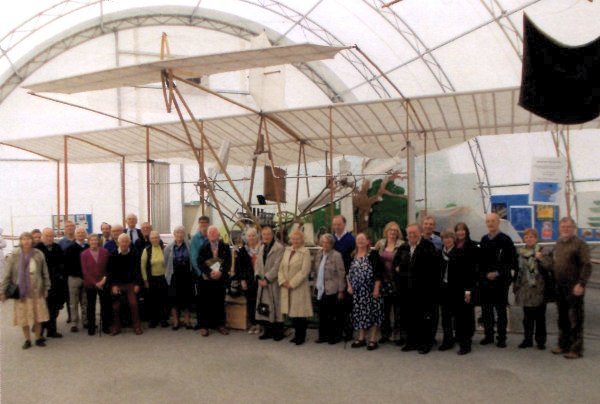
A contast in histories: the Trust visit to Farnborough - TrustNews Jun 14
Trust members drove to Farnborough on 24th April 2014 to see two institutions within a mile or so of each other that could scarcely have been more different, even though both are concerned with history. One was famous the world over, the other perhaps Farnborough’s best kept secret. In the morning we went to see the Farnborough Air Sciences Trust, FAST. We were met by Dr Graham Flood and several volunteer members of FAST in the room in which Lord Trenchard had formed the Royal Air Force by merging the Royal Flying Corps with the Royal Naval Air Service. Now that the Royal Aircraft Establishment has closed, FAST is in a race against time to gather the records and experimental devices which were held by the RAE, so as to record, display and explain the history of this cradle of British aviation. We were delighted by the enthusiasm of everyone we met for the project.
The highlight for me was the amazing replica they have made of the first British military aeroplane, British Army Aeroplane No. 1A. The original was designed, built and finally flown by Colonel Samuel Franklin Cody (not “Buffalo Bill" Cody) in 1908. He was clearly a remarkable man; energetic, enthusiastic, inventive, skilled and brave. He had to struggle with the bureaucracy for funding, even paying for the work himself at one point. There were several military people at that time who thought balloons would suit them better than aeroplanes. They pointed out that aeroplanes flew at 40 mph and maintained that at that speed they would see nothing. The replica has been beautifully constructed from authentic materials such as bamboo, wood, piano wire and many specialised aluminium castings, using photographs of the original to recreate the engineering drawings. It is a joy to see, but frightening to imagine trusting oneself to such a flimsy aeroplane.
The museum houses numerous interesting experimental devices such as an early development model of the Whittle jet engine and experimental wind tunnel devices. Carbon fibre reinforced plastics were invented at Farnborough and are now widely used all over the world for critical, high-performance applications. Early samples of spools of carbon fibre show the work to find a practical technique for making these exceptionally strong threads.
After lunch the group drove to St. Michael's Abbey. What a contrast to find the Abbey in silent woods scarcely more than a mile away! It was built by the Empress Eugenie as a fitting monument in which to house the tomb of her late husband, the Emperor Napoleon III who had been exiled from France as a result of the Franco-Prussian war of 1871. Entombed in the same crypt are the bodies of his son the Prince Imperial, killed as a young man while serving with the British Army in Zululand, and the Empress herself at the end of her long and generous life. Trust members were fortunate to have Michael Carden, Vice-Chairman of the Trust, with them, as he had worked on the restoration of the Abbey which began in 1998, and explained how they had dealt with the problems that they had faced.
The Abbey church, a grade one listed building, was the work of the important French architect Gabriel Hippolyte Destailleur who had built Waddesdon Manor for the Rothschilds. It is in Gothic revival style, and its roof includes a cupola, dolphins and several immense pinnacles, two of which had fallen down causing further damage. It also features many two metre long gargoyles which strangely are purely decorative, carrying no rain water.
We are grateful to lain Patton for arranging such an interesting and contrasting day for us.
